When Death Came
A-Calling
by Bob Brooke
The Victorians had almost an obsession
with death. This developed out of the harshness of life during their
time and because of certain life-changing events of the day.
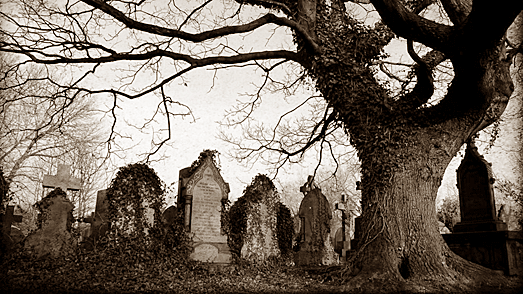 The Harshness of Everyday Life
Except for the upper and upper middle classes, most Victorians led a
hard life. Conveniences that ease life today weren’t heard of back then.
The Industrial Revolution did wonders for production, but workers
suffered hardships daily. And many died on the job from a lack of safety
regulations.
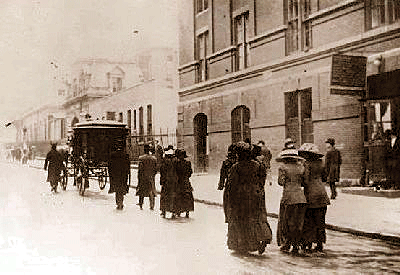 Medical advancements were nonexistent. Women died in childbirth, and
disease was rampant. That the various forms of epidemic, endemic, and
other disease caused, or aggravated, or propagated chiefly among the
working class by atmospheric impurities produced by decomposing animal
and vegetable substances, by damp and filth, and close and overcrowded
dwellings prevailed amongst the population, whether dwelling in separate
houses, in rural villages, in small towns, in the larger towns. Medical advancements were nonexistent. Women died in childbirth, and
disease was rampant. That the various forms of epidemic, endemic, and
other disease caused, or aggravated, or propagated chiefly among the
working class by atmospheric impurities produced by decomposing animal
and vegetable substances, by damp and filth, and close and overcrowded
dwellings prevailed amongst the population, whether dwelling in separate
houses, in rural villages, in small towns, in the larger towns.
Defective supplies of water for drinking, cooking, and bathing
contributed to the spread of disease as did the lack of habits of
cleanliness among the middle and working classes. During Victorian
times, the annual loss of life from filth and bad ventilation were
greater than the loss from death or wounds in any wars in which America
has been engaged in during modern times. And finally, the premature
deaths of heads of households forced many women and their children to
live a life of poverty.
Events of the Day
On April 12, 1861, after many years of tension over the injustice of
slavery, the first shot of the American Civil War rang out. Death was
rampant and grief overshadowed both the North and South I as more than a
million lives were lost. When the war officially ended on April 9, 1865,
the end was actually still far from sight, as six days later an
assassin's bullet killed President Lincoln while he was attending a play
at Ford's Theater. As these tragic events unfolded, a crippled nation
already reeling from the devastation of war was further shrouded with
grief.

In England a different sort of' tragedy occurred. On December 14, 1861,
Queen Victoria woke to find that Albert, her beloved husband of 21
years, had died in his sleep of typhoid. Deeply distressed, Victoria
went into full mourning and the nation, out of respect and love,
followed her example. All members of the royal court dressed in black
and an atmosphere of grief permeated society. It was customary during
this time for a widow to remain in full mourning for a period of two
years, and then half mourning for six months—however, the Queen never
stopped grieving. In fact, she directed her servants to wear black crepe
armbands for eight years.
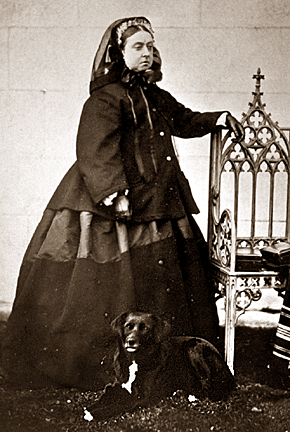 Victoria wore black the remainder of her life. Rarely seen in public,
she continued her responsibilities including official correspondence and
meeting with her ministers and office visitors. The Queen, however,
slowly resumed her public contact after opening Parliament in 1866 and
1867. Victoria wore black the remainder of her life. Rarely seen in public,
she continued her responsibilities including official correspondence and
meeting with her ministers and office visitors. The Queen, however,
slowly resumed her public contact after opening Parliament in 1866 and
1867.
These two tragic events in 1861 over-shadowed society on both sides of
the Atlantic ocean for several decades. By the 1890s however, fashion
and attitude had lightened a great deal, and the mementos of grief were
respectfully tucked away for posterity. The symbolic images of sorrow,
love and devotion that were carved and molded into the accouterments of
mourning are a somber reminder of the time when society dictated what
was acceptable behavior in the event of bereavement.
During the Victorian period, certain "rules" existed regarding mourning.
When a death occurred in the family, the servants were provided mourning
garments by the family. The color and clothing adornment also reflected
the event. The color and type of changes to clothing indicated who in
the family had died.
Mourning Attire
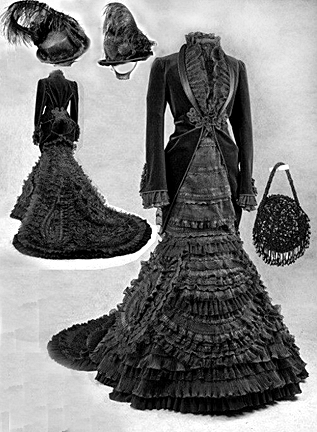 During the full mourning period, all black clothing was worn and
decorative accessories were kept at a minimum. Simple unadorned black
straw hats were draped with mourning veils of fine black linen or lace,
and for children black hats were sometimes decorated with dark silk
flower sprays of forget-me-nots, roses, or morning glories. Black fans,
tear catchers, mourning hankies and parasols, were also considered
necessary regalia for the bereaved. Hair combs, buttons and jewelry
items were hand carved and molded in a limited variety of dark
materials, often bearing symbolic images that represented death, grief,
devotion and eternal life. Black frames and daguerreotype cases held
images of loved ones, as did "lockets" which also were designed to hold
a "lock" of hair from the dearly departed. During the full mourning period, all black clothing was worn and
decorative accessories were kept at a minimum. Simple unadorned black
straw hats were draped with mourning veils of fine black linen or lace,
and for children black hats were sometimes decorated with dark silk
flower sprays of forget-me-nots, roses, or morning glories. Black fans,
tear catchers, mourning hankies and parasols, were also considered
necessary regalia for the bereaved. Hair combs, buttons and jewelry
items were hand carved and molded in a limited variety of dark
materials, often bearing symbolic images that represented death, grief,
devotion and eternal life. Black frames and daguerreotype cases held
images of loved ones, as did "lockets" which also were designed to hold
a "lock" of hair from the dearly departed.
Men wore black armbands. In wealthy families, the coachman wore a black
band on his right arm. The footman wore a black band on his left arm. In
this way, the black bands were "symmetrical when seated upon the box" of
the coach. Even the horses were harnessed in black with livery crest
buttons changed to black as well as the horses' harnesses.
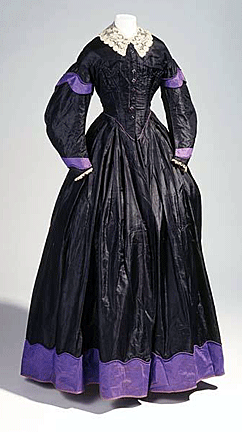 By the late 19th century, female servants wore dresses, bonnets, collars
and cuffs of black crepe. Male servants wore black suits, ties and
armbands. All servants were provided two sets of mourning clothes. One
set was worn for work, the other on Sunday and reception days. By the late 19th century, female servants wore dresses, bonnets, collars
and cuffs of black crepe. Male servants wore black suits, ties and
armbands. All servants were provided two sets of mourning clothes. One
set was worn for work, the other on Sunday and reception days.
Victorian mourning protocol prescribed certain periods of time for
mourning. After a suitable period—usually a year to two years—full
mourning attire could be put aside for half-mourning attire. For a
female servant, this might include wearing white trim on her dress,
sleeves, and collar.
During the six-month half mourning period, it was acceptable to don
white lace jabots, collars and cuffs, as well as dark shades of gray and
deep brown. Pearls, symbolic of tears and diamonds representing devotion
were also incorporated into the look. As these changes were reintroduced
to the wardrobe, it became acceptable for the bereaved to re-enter
society.
But when a child, an unmarried woman, or a lady died in childbirth, the
color of mourning attire was white. However, men related to them wore
black armbands.
Mementos of Grief
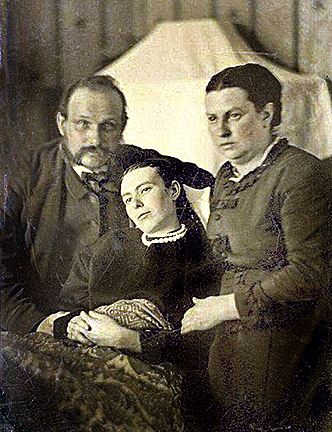 One of the more morbid Victorian mourning practices was death
photography. Photographs of loved ones taken after they died may seem
morbid to modern sensibilities. But in Victorian England, they became a
way of commemorating the dead and blunting the sharpness of grief.
Victorian life was suffused with death.
Victorians took photos of their dead relatives posing on couches, in
beds, and even in coffins. One of the more morbid Victorian mourning practices was death
photography. Photographs of loved ones taken after they died may seem
morbid to modern sensibilities. But in Victorian England, they became a
way of commemorating the dead and blunting the sharpness of grief.
Victorian life was suffused with death.
Victorians took photos of their dead relatives posing on couches, in
beds, and even in coffins.
Another was the wearing of special mourning jewelry. Symbolic images of
sorrow, love and devotion were the custom at the time. Men and women
wore carved and molded pieces of mourning jewelry, an acceptable
behavior during the bereavement period. But by the 1890s, fashion and
attitude had lightened, and people tucked the mementos of grief away for
posterity.
In the beginning of the 1860s the material of choice for black jewelry
was jet, a hard type of lignite coal that was found along the Yorkshire
coast of England. The best jet, which was found along the rocky
shoreline, had a compact mineral structure making it strong enough to
withstand carving and turning on a lathe. Jet also retained a high
polish and resisted fading. As a result, an entire industry was
developed around the mining and fabrication of jet during the mid-1800s
in the small coastal village of Whitby.
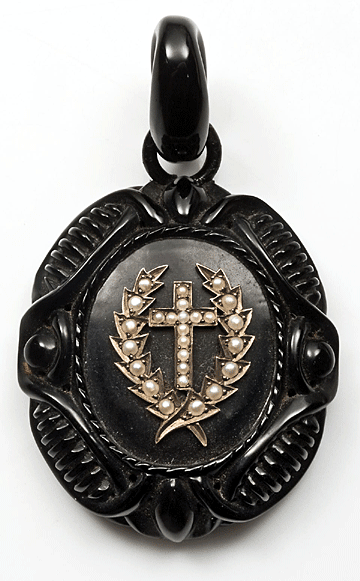 At one time, the natural supply of jet was so plentiful it was possible
to find substantial chunks of the shiny black substance washed up along
the shore. Eventually however, the supply of true jet dwindled to the
point of shortage and a replacement source was needed. Coal was found in
lower York, and mined from estuarine beds where the tide washed into
fresh water channels. This alternative jet was of an inferior quality.
It was soft and did not respond to carving and polishing as well as the
Whitby variety. At one time, the natural supply of jet was so plentiful it was possible
to find substantial chunks of the shiny black substance washed up along
the shore. Eventually however, the supply of true jet dwindled to the
point of shortage and a replacement source was needed. Coal was found in
lower York, and mined from estuarine beds where the tide washed into
fresh water channels. This alternative jet was of an inferior quality.
It was soft and did not respond to carving and polishing as well as the
Whitby variety.
The industry then turned to other sources for their supplies, and
Spanish jet and Cannel coal (bituminous) from Scotland were , imported
to Whitby for incorporation into the trade. While these types of coal
lacked hardness and luster, it was still better than the coal from
southern' Yorkshire and jewelry components were soon being carved into
shape from these alternatives, and then combined with decorative
components fashioned from true Whitby jet.
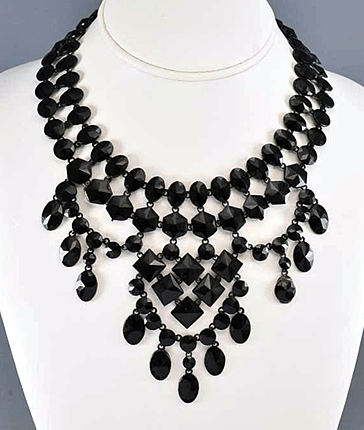 When supplies of alternative jet became difficult to come by, other
black materials were sought out. Black onyx, a form of chalcedony, was
used in some jewelry forms, and French jet; also called Vauxhall, became
equally popular. In reality, French jet and Vauxhall are black glass,
and it became an excellent substitute for true jet because it remained
shiny and would not fade. It is often difficult to tell the difference
between authentic and faux jet by sight alone, but upon handling the
materials one can easily tell the difference. Black glass is heavy and
cold to the touch because it does not conduct heat, whereas true jet is
light and room temperature. The details on _ carved jet item$ are often
clean and sharp, while molded black glass may not be as defined and can
also show signs of chipping or flaking. When supplies of alternative jet became difficult to come by, other
black materials were sought out. Black onyx, a form of chalcedony, was
used in some jewelry forms, and French jet; also called Vauxhall, became
equally popular. In reality, French jet and Vauxhall are black glass,
and it became an excellent substitute for true jet because it remained
shiny and would not fade. It is often difficult to tell the difference
between authentic and faux jet by sight alone, but upon handling the
materials one can easily tell the difference. Black glass is heavy and
cold to the touch because it does not conduct heat, whereas true jet is
light and room temperature. The details on _ carved jet item$ are often
clean and sharp, while molded black glass may not be as defined and can
also show signs of chipping or flaking.
But for the Victorians, jet symbolized the deep emotional tie to a loved
one through death.
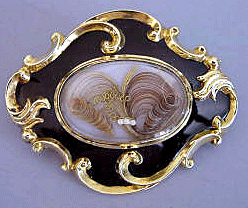 Another mourning practice of the Victorians was to wear pieces of
jewelry that contained locks of hair or other mementos of the deceased.
This became so common that artists crafted bouquets of flowers encased
in elaborate frames or created three-dimensional bouquets displayed
under glass domes. Another mourning practice of the Victorians was to wear pieces of
jewelry that contained locks of hair or other mementos of the deceased.
This became so common that artists crafted bouquets of flowers encased
in elaborate frames or created three-dimensional bouquets displayed
under glass domes.
Death pervaded Victorian life and mourning practices and attire because
an everyday sight
<
More Special Features
Next Article > |
